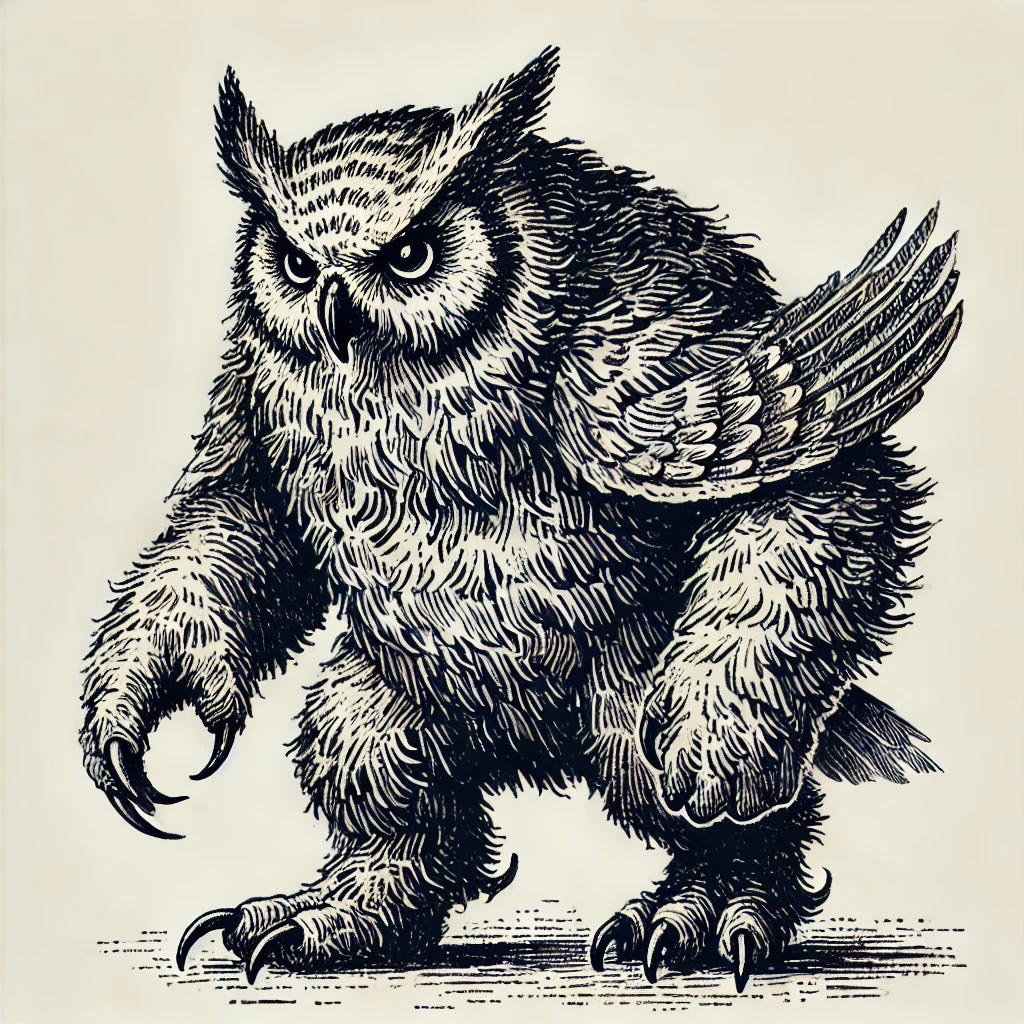The Owlbear: A Beast of Unmatched Ferocity
Today's AD&D article...
When you think of classic monsters that have become iconic within the realm of Advanced Dungeons & Dragons, it’s hard not to think of the Owlbear. This fearsome creature doesn’t rely on the trickery of spells or the intricacies of intelligence—it is pure, primal force, a brutal clash of two of nature’s most lethal hunters: an owl and a bear.
The Owlbear isn’t one of those creatures you find hiding in the shadows, waiting to ambush players. It is in your face, aggressive, and absolutely terrifying when encountered. But despite its monstrosity, the Owlbear is a creature that offers more than just a random encounter—it can be woven into your campaign as a symbol of untamed wilderness, a guardian of sacred places, or even as a pitiless adversary to be slain.
So let’s get into it.
The Owlbear is a hybrid beast, an unnatural combination of an owl and a bear. It stands about 8 feet tall and weighs several hundred pounds, making it a formidable opponent even for experienced adventurers. It has the body of a bear, thick with muscle and covered in fur, and the head of an owl, complete with sharp, predatory eyes and a beak that can crush bone. It also possesses powerful talons, making it a dual threat in both ranged and close combat.
In combat, the Owlbear relies on brute force. It can claw and bite, tearing through armor and flesh with ease. But it also has the added ability of a screech that can be disorienting, particularly when the Owlbear is in its element—deep in forests, where its keen senses make it a master of its domain. The screech of an Owlbear can unnerve even the bravest adventurers, causing fear and confusion in the heat of battle.
What makes the Owlbear so dangerous is its relentless nature. Unlike more cunning creatures, like the Mimic or the Beholder, the Owlbear does not need to outwit its prey. It is purely a beast of instinct, driven by hunger and territoriality. It doesn’t plan or scheme—it just strikes, and it strikes hard.
The Owlbear’s physical strength is its greatest asset. With a bite that can tear through most armors and claws that can rip into its prey with ease, it is a challenge even for high-level adventurers. What makes the encounter even more intense is its ability to attack in rapid succession, mixing bites, claws, and its devastating screech in a flurry of attacks.
What’s more, the Owlbear has a terrifying sense of hearing and sight, making it difficult to sneak past. It thrives in forested environments or deep in caves, where its senses are amplified, and it can become a true predator in the darkness. If players don’t take care, an Owlbear can strike before they even know it’s there.
Ways to use him as a Dungeon Master
While the Owlbear is a straightforward creature when it comes to combat, it also offers interesting narrative possibilities. This creature doesn’t have a culture or civilization, but it can still play a role in a campaign that explores themes of nature, wilderness, and survival.
In many settings, the Owlbear is known as a guardian creature. It might protect an ancient temple, a hidden forest glade, or a sacred place. Players who venture into these areas may not be seeking an encounter with an Owlbear, but rather the location it guards. A lone Owlbear may not attack unless provoked, but if players disturb its territory or threaten the land it defends, they might find themselves in a fight for their lives.
This can also present an interesting moral dilemma for players. Are they willing to kill the creature to get what they want, or can they find a way to live in harmony with the wilderness? The Owlbear’s very nature suggests that it is simply an animal—wild, untamed, and driven by instinct. Players might find themselves wondering if their battle is with the creature itself, or with the environment that has shaped it.
An Owlbear encounter can be used in a variety of ways, depending on what you, as the Dungeon Master, want to emphasize in your campaign. On one hand, the Owlbear is an excellent creature for simple, no-nonsense combat. If your players are in the mood for a straight-up brawl with a dangerous beast, an Owlbear encounter is perfect for that.
In some campaigns, the Owlbear could even become a key figure in the larger narrative: a creature that tests the resolve of adventurers, a challenge they must overcome to prove their worth, or a being they must confront to access ancient knowledge hidden within the wilderness.
For instance, an Owlbear might guard a path to an ancient druidic circle, where powerful magic is sealed away. The party may need to figure out how to pacify or bypass the Owlbear, all while dealing with the knowledge that they are in the territory of a dangerous, unpredictable predator.
On the other hand, the Owlbear could simply be a part of the natural world, encountered by the adventurers as they travel through a dark forest or venture into the mountains. Perhaps it’s a challenge that tests the adventurers’ ability to survive in the wilderness. The creature could even be a red herring, a moment of tension where players think they’ve encountered a greater threat, only to discover it’s just another wild animal.
so to wrap things up…
Whether used as a lone beast in the wild, a guardian of a sacred site, or even a symbol of the untamed forces of nature, the Owlbear is a monster that’s far more than just a bear with an owl’s head. It’s a creature that leaves a lasting impression on players, a reminder of the unpredictable and raw power that lies within the wilds.
Enjoying the content on this blog, why not consider donating or tipping a buck?





Such a classic!